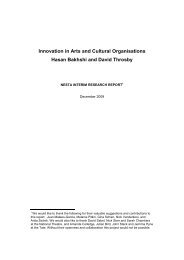Rumbling on performativity_Frits Simon
Rumbling on performativity_Frits Simon
Rumbling on performativity_Frits Simon
You also want an ePaper? Increase the reach of your titles
YUMPU automatically turns print PDFs into web optimized ePapers that Google loves.
Varying ways of pushing through a definiti<strong>on</strong> of reality are at hand. In our c<strong>on</strong>temporary<br />
civilized western society it is precluded that in daily life we use physical force to<br />
superimpose our definiti<strong>on</strong>s of reality (Elias, 1969). In general we use courts of law,<br />
coaliti<strong>on</strong>s, debate or meetings to overcome our differences. In the course of the 20th<br />
century (Dutch) civilized people even had to switch from a commanding attitude to a<br />
negotiating attitude, in which “... those involved regulate their interacti<strong>on</strong> in mutual<br />
c<strong>on</strong>sultati<strong>on</strong> and approval.” (Swaan, 1979: 98). As a rule a negotiating attitude as the<br />
hallmark of ordinary good behaviour in our (Dutch) society is cloaked in the manifold<br />
of our c<strong>on</strong>versati<strong>on</strong>s, in our paperwork and in our symbolic representati<strong>on</strong>s of reality<br />
in for instance brands, movies, pictures and fashi<strong>on</strong>. Communicati<strong>on</strong> has got a tremendous<br />
importance regarding in whatever we do, including or maybe especially<br />
regarding a subject like identity-management. Subtleties of different epistemological<br />
strategies of including (and thus excluding) and reciprocal power are at work in the<br />
process of defining reality (Foucault, 1966, 1971). Uncovering the ways reality is defined<br />
<strong>on</strong> the micro level helps to explain how policy is brought about.<br />
Two discourses compromising<br />
As it has a great impact <strong>on</strong> defining reality the <strong>on</strong>going battle between a social systems-change<br />
discourse and a co-creative discourse within the UAS is to be exemplified<br />
in the discussi<strong>on</strong>s around the c<strong>on</strong>clusi<strong>on</strong>s and recommendati<strong>on</strong>s.<br />
C<strong>on</strong>ceptually there is a sharp distincti<strong>on</strong> between these two approaches of development<br />
and change. On a discursive level a main difference between the approaches is<br />
that the first <strong>on</strong>e supposes that reality is stable, predictable and to a great extent<br />
c<strong>on</strong>trollable. Rati<strong>on</strong>ality is supposed to rule. In the social systems change discourse<br />
quasi outside managers and experts are dominant (Pars<strong>on</strong>s, 2007; Stacey, 2007). This<br />
approach incorporates a neat system of missi<strong>on</strong> statements, midterm strategy development,<br />
yearly planning and evaluati<strong>on</strong> and it is practised in the UAS.<br />
The co-creative discourse postulates that reality is changing, and interacti<strong>on</strong> and<br />
collective learning are needed whereby “... patterns of thinking and acting are dismantled<br />
and composed: dec<strong>on</strong>structi<strong>on</strong> and rec<strong>on</strong>structi<strong>on</strong>.” (Wierdsma and Swieringa,<br />
1990: 179).The co-creative discourse sets course <strong>on</strong> the willingness of people to<br />
cooperate. In the UAS co-creati<strong>on</strong> is am<strong>on</strong>gst others advocated in developing educati<strong>on</strong>al<br />
courses and doing research in cooperati<strong>on</strong> with representatives of external<br />
organizati<strong>on</strong>s and companies.<br />
The discourses get extra dimensi<strong>on</strong>s if plotted in quadrants in which the way an<br />
organizati<strong>on</strong> develops and changes is differentiated al<strong>on</strong>g axes of m<strong>on</strong>ovocal/polyvocal<br />
and planning/sp<strong>on</strong>taneity (Homan, 2005, 2006). Homan uses this quadrant to<br />
show that in reality change is always a sp<strong>on</strong>taneous many voiced (‘polyvocal’) affair. In<br />
recent research regarding organizati<strong>on</strong>al values in UAS’s a differentiati<strong>on</strong> is made<br />
between c<strong>on</strong>trol-oriented and flexibility-oriented organizati<strong>on</strong>al value models. It was<br />
found that “... these are not mutually exclusive. In fact, they are in competiti<strong>on</strong>.”<br />
98



